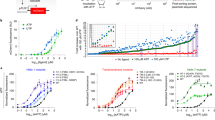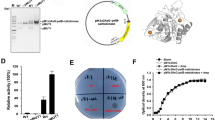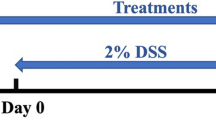Abstract
Inflammatory bowel disease is a lifelong disorder that involves chronic inflammation in the small and large intestines. Current therapies, including aminosalicylates, corticosteroids, and anti-inflammatory biologics, can only alleviate the symptoms and often cause adverse effects with long-term usage. Engineered probiotics provide an alternative approach to treat inflammatory bowel disease in a self-renewable and local delivery fashion. In this work, we utilized a yeast probiotic Saccharomyces boulardii for this purpose. We developed a robust method to integrate recombinant genes into the Ty elements of S. boulardii. Stable yeast cell lines that secreted various anti-inflammatory proteins, including IL-10, TNFR1-ECD, alkaline phosphatase, and atrial natriuretic peptide (ANP), were successfully created and investigated for their efficacies to the DSS-induced colitis in mice through oral administration. While IL-10, TNFR1-ECD, and alkaline phosphatase did not show therapeutic effects, the ANP-secreting S. boulardii effectively ameliorated the mouse conditions as reflected by the improvements in body weight, disease activity index, and survival rate. A post-mortem examination revealed that the ANP-treated mice exhibited significant downregulations of TNF-α and IL-1β and an upregulation of IL-6 in colon tissues. This observation is consistent with the previous reports showing that TNF-α and IL-1β are responsible for initiating the pathogenesis, whereas IL-6 plays a protective role in colitis. Overall, we demonstrated that S. boulardii is a safe and robust vehicle for recombinant protein delivery in the gastrointestinal tract, and ANP is a potential anti-inflammatory drug for colitis treatment.
Key messages
-
Recombinant genes can be robustly integrated into the transposable elements of S. boulardii.
-
Oral administration of S. boulardii secreting IL-10 or TNF-α inhibitor did not exert therapeutic effects for DSS-induced colitis in mice.
-
Atrial natriuretic peptide–secreting S. boulardii effectively ameliorated the murine colitis as reflected by improved body weight, disease activity index, and survival rate.
-
The ANP-treated mice exhibited decreased mRNA levels of TNF-α and IL-1β and an increased mRNA level of IL-6 in colon tissues.






Similar content being viewed by others
References
Guan Q (2019) A comprehensive review and update on the pathogenesis of inflammatory bowel disease. J Immunol Res 2019:7247238
Bernstein CN, Shanahan F (2008) Disorders of a modern lifestyle: reconciling the epidemiology of inflammatory bowel diseases. Gut 57:1185–1191
Kaplan GG, Ng SC (2017) Understanding and preventing the global increase of inflammatory bowel disease. Gastroenterology 152(313-321):e312
Eisenstein M (2016) Biology: A slow-motion epidemic. Nature 540:S98–S99
Ko JK, Auyeung KK (2014) Inflammatory bowel disease: etiology, pathogenesis and current therapy. Curr Pharm Des 20:1082–1096
Fiocchi C (1998) Inflammatory bowel disease: etiology and pathogenesis. Gastroenterology 115:182–205
van Loo ES, Dijkstra G, Ploeg RJ, Nieuwenhuijs VB (2012) Prevention of postoperative recurrence of Crohn’s disease. J Crohns Colitis 6:637–646
Lichtenstein GR, Shahabi A, Seabury SA, Lakdawalla DN, Espinosa OD, Green S, Brauer M, Baldassano RN (2020) Lifetime economic burden of Crohn’s disease and ulcerative colitis by age at diagnosis. Clin Gastroenterol Health 18:889
Taylor KM, Irving PM (2011) Optimization of conventional therapy in patients with IBD. Nat Rev Gastroenterol Hepatol 8:646–656
Adegbola SO, Sahnan K, Warusavitarne J, Hart A, Tozer P (2018) Anti-TNF Therapy in Crohn’s disease. Int J Mol Sci 19
Weaver KN, Gregory M, Syal G, Hoversten P, Hicks SB, Patel D, Christophi G, Beniwal-Patel P, Isaacs KL, Raffals L, Deepak P, Herfarth HH, Barnes EL (2019) Ustekinumab is effective for the treatment of Crohn’s disease of the pouch in a multicenter cohort. Inflamm Bowel Dis 25:767–774
Friedrich M, Pohin M, Powrie F (2019) Cytokine networks in the pathophysiology of inflammatory bowel disease. Immunity 50:992–1006
Dinarello CA, Simon A, van der Meer JW (2012) Treating inflammation by blocking interleukin-1 in a broad spectrum of diseases. Nat Rev Drug Discov 11:633–652
Danese S, Vermeire S, Hellstern P, Panaccione R, Rogler G, Fraser G, Kohn A, Desreumaux P, Leong RW, Comer GM, Cataldi F, Banerjee A, Maguire MK, Li C, Rath N, Beebe J, Schreiber S (2019) Randomised trial and open-label extension study of an anti-interleukin-6 antibody in Crohn’s disease (ANDANTE I and II). Gut 68:40–48
Jovani M, Fiorino G, Danese S (2013) Anti-IL-13 in inflammatory bowel disease: from the bench to the bedside. Curr Drug Targets 14:1444–1452
Fitzpatrick LR (2013) Inhibition of IL-17 as a pharmacological approach for IBD. Int Rev Immunol 32:544–555
Abraham BP, Quigley EMM (2017) Probiotics in inflammatory bowel disease. Gastroenterol Clin N Am 46:769–782
Becker C, Neurath MF, Wirtz S (2015) The intestinal microbiota in inflammatory bowel disease. ILAR J 56:192–204
Zuo T, Ng SC (2018) The gut microbiota in the pathogenesis and therapeutics of inflammatory bowel disease. Front Microbiol 9:2247
Khan I, Ullah N, Zha L, Bai Y, Khan A, Zhao T, Che T, Zhang C (2019) Alteration of gut microbiota in inflammatory bowel disease (IBD): cause or consequence? IBD Treatment Targeting the Gut Microbiome Pathogens 8
Scaldaferri F, Gerardi V, Lopetuso LR, Del Zompo F, Mangiola F, Boskoski I, Bruno G, Petito V, Laterza L, Cammarota G, Gaetani E, Sgambato A, Gasbarrini A (2013) Gut microbial flora, prebiotics, and probiotics in IBD: their current usage and utility. Biomed Res Int.
Zocco MA, dal Verme LZ, Cremonini F, Piscaglia AC, Nista EC, Candelli M, Novi M, Rigante D, Cazzato IA, Ojetti V, Armuzzi A, Gasbarrini G, Gasbarrini A (2006) Efficacy of Lactobacillus GG in maintaining remission of ulcerative colitis. Aliment Pharmacol Ther 23:1567–1574
Bibiloni R, Fedorak RN, Tannock GW, Madsen KL, Gionchetti P, Campieri M, De Simone C, Sartor RB (2005) VSL#3 probiotic-mixture induces remission in patients with active ulcerative colitis. Am J Gastroenterol 100:1539–1546
Guslandi M, Mezzi G, Sorghi M, Testoni PA (2000) Saccharomyces boulardii in maintenance treatment of Crohn's disease. Dig Dis Sci 45:1462–1464
Barra M, Danino T, Garrido D (2020) Engineered probiotics for detection and treatment of inflammatory intestinal diseases. Front Bioeng Biotechnol 8:265
Steidler L, Hans W, Schotte L, Neirynck S, Obermeier F, Falk W, Fiers W, Remaut E (2000) Treatment of murine colitis by Lactococcus lactis secreting interleukin-10. Science 289:1352–1355
Vandenbroucke K, de Haard H, Beirnaert E, Dreier T, Lauwereys M, Huyck L, Van Huysse J, Demetter P, Steidler L, Remaut E, Cuvelier C, Rottiers P (2010) Orally administered L. lactis secreting an anti-TNF nanobody demonstrate efficacy in chronic colitis. Mucosal Immunol 3:49–56
Vandenbroucke K, Hans W, Van Huysse J, Neirynck S, Demetter P, Remaut E, Rottiers P, Steidler L (2004) Active delivery of trefoil factors by genetically modified Lactococcus lactis prevents and heals acute colitis in mice. Gastroenterology 127:502–513
Praveschotinunt P, Duraj-Thatte AM, Gelfat I, Bahl F, Chou DB, Joshi NS (2019) Engineered E. coli Nissle 1917 for the delivery of matrix-tethered therapeutic domains to the gut. Nat Commun 10:5580
Gietz RD, Schiestl RH (2007) High-efficiency yeast transformation using the LiAc/SS carrier DNA/PEG method. Nat Protoc 2:31–34
Chan KM, Liu YT, Ma CH, Jayaram M, Sau S (2013) The 2 micron plasmid of Saccharomyces cerevisiae: a miniaturized selfish genome with optimized functional competence. Plasmid 70:2–17
Jensen NB, Strucko T, Kildegaard KR, David F, Maury J, Mortensen UH, Forster J, Nielsen J, Borodina I (2014) EasyClone: method for iterative chromosomal integration of multiple genes in Saccharomyces cerevisiae. FEMS Yeast Res 14:238–248
Stovicek V, Borja GM, Forster J, Borodina I (2015) EasyClone 2.0: expanded toolkit of integrative vectors for stable gene expression in industrial Saccharomyces cerevisiae strains. J Ind Microbiol Biotechnol 42:1519–1531
Carr M, Bensasson D, Bergman CM (2012) Evolutionary genomics of transposable elements in Saccharomyces cerevisiae. PLoS One 7:e50978
Maury J, Germann SM, Baallal Jacobsen SA, Jensen NB, Kildegaard KR, Herrgard MJ, Schneider K, Koza A, Forster J, Nielsen J, Borodina I (2016) EasyCloneMulti: a set of vectors for simultaneous and multiple genomic integrations in Saccharomyces cerevisiae. PLoS One 11:e0150394
Batista TM, Marques ET, Jr., Franco GR, Douradinha B (2014) Draft genome sequence of the probiotic yeast Saccharomyces cerevisiae var. boulardii Strain ATCC MYA-796. Genome Announc 2.
Hutchins AP, Diez D, Miranda-Saavedra D (2013) The IL-10/STAT3-mediated anti-inflammatory response: recent developments and future challenges. Brief Funct Genomics 12:489–498
Bates JM, Akerlund J, Mittge E, Guillemin K (2007) Intestinal alkaline phosphatase detoxifies lipopolysaccharide and prevents inflammation in zebrafish in response to the gut microbiota. Cell Host Microbe 2:371–382
Song W, Wang H, Wu Q (2015) Atrial natriuretic peptide in cardiovascular biology and disease (NPPA). Gene 569:1–6
Kiemer AK, Vollmar AM (2001) The atrial natriuretic peptide regulates the production of inflammatory mediators in macrophages. Ann Rheum Dis 60(Suppl 3):iii68–iii70
Robinson AS, Hines V, Wittrup KD (1994) Protein disulfide isomerase overexpression increases secretion of foreign proteins in Saccharomyces cerevisiae. Biotechnology (N Y) 12:381–384
Cunningham BC, Lowe DG, Li B, Bennett BD, Wells JA (1994) Production of an atrial natriuretic peptide variant that is specific for type A receptor. EMBO J 13:2508–2515
Reinecker HC, Steffen M, Witthoeft T, Pflueger I, Schreiber S, MacDermott RP, Raedler A (1993) Enhanced secretion of tumour necrosis factor-alpha, IL-6, and IL-1 beta by isolated lamina propria mononuclear cells from patients with ulcerative colitis and Crohn's disease. Clin Exp Immunol 94:174–181
Grivennikov S, Karin E, Terzic J, Mucida D, Yu GY, Vallabhapurapu S, Scheller J, Rose-John S, Cheroutre H, Eckmann L, Karin M (2009) IL-6 and Stat3 are required for survival of intestinal epithelial cells and development of colitis-associated cancer. Cancer Cell 15:103–113
Partow S, Siewers V, Bjorn S, Nielsen J, Maury J (2010) Characterization of different promoters for designing a new expression vector in Saccharomyces cerevisiae. Yeast 27:955–964
Blazeck J, Garg R, Reed B, Alper HS (2012) Controlling promoter strength and regulation in Saccharomyces cerevisiae using synthetic hybrid promoters. Biotechnol Bioeng 109:2884–2895
Kjaerulff S, Jensen MR (2005) Comparison of different signal peptides for secretion of heterologous proteins in fission yeast. Biochem Biophys Res Commun 336:974–982
Rakestraw JA, Sazinsky SL, Piatesi A, Antipov E, Wittrup KD (2009) Directed evolution of a secretory leader for the improved expression of heterologous proteins and full-length antibodies in Saccharomyces cerevisiae. Biotechnol Bioeng 103:1192–1201
Wang TT, Sun H, Zhang J, Liu Q, Wang LJ, Chen PP, Wang FK, Li HM, Xiao YH, Zhao XM (2014) The establishment of Saccharomyces boulardii surface display system using a single expression vector. Fungal Genet Biol 64:1–10
Tanaka T, Yamada R, Ogino C, Kondo A (2012) Recent developments in yeast cell surface display toward extended applications in biotechnology. Appl Microbiol Biotechnol 95:577–591
Shi Y, Zheng W, Yang K, Harris KG, Ni K, Xue L, Lin W, Chang EB, Weichselbaum RR, Fu YX (2020) Intratumoral accumulation of gut microbiota facilitates CD47-based immunotherapy via STING signaling. J Exp Med 217.
Chowdhury S, Castro S, Coker C, Hinchliffe TE, Arpaia N, Danino T (2019) Programmable bacteria induce durable tumor regression and systemic antitumor immunity. Nat Med 25:1057–1063
Vellaichamy E, Kaur K, Pandey KN (2007) Enhanced activation of pro-inflammatory cytokines in mice lacking natriuretic peptide receptor-A. Peptides 28:893–899
Staedtke V, Bai RY, Kim K, Darvas M, Davila ML, Riggins GJ, Rothman PB, Papadopoulos N, Kinzler KW, Vogelstein B, Zhou S (2018) Disruption of a self-amplifying catecholamine loop reduces cytokine release syndrome. Nature 564:273–277
Ehrenreich H, Sinowatz F, Schulz R, Arendt RM, Goebel FD (1989) Immunoreactive atrial natriuretic peptide (ANP) in endoscopic biopsies of the human gastrointestinal tract. Res Exp Med (Berl) 189:421–425
Matsushita K, Nishida Y, Hosomi H, Tanaka S (1991) Effects of atrial natriuretic peptide on water and NaCl absorption across the intestine. Am J Phys 260:R6–R12
Lee CH, Ha GW, Kim JH, Kim SH (2016) Modulation in Natriuretic Peptides System in Experimental Colitis in Rats. Dig Dis Sci 61:1060–1068
Moro C, Klimcakova E, Lolmede K, Berlan M, Lafontan M, Stich V, Bouloumie A, Galitzky J, Arner P, Langin D (2007) Atrial natriuretic peptide inhibits the production of adipokines and cytokines linked to inflammation and insulin resistance in human subcutaneous adipose tissue. Diabetologia 50:1038–1047
Acknowledgments
We thank the Flow Cytometry Core of Institute of Biomedical Sciences for their technical supports. We also thank the Academia Sinica DNA Sequencing Core Facility (AS-CFII-108-115).
Funding
This work was supported by an Academia Sinica Career Development Award (AS-CDA-108-L07) and the Ministry of Science and Technology, Taiwan (107-2113-M-001-013).
Author information
Authors and Affiliations
Contributions
CHL and KYM conceived and designed the experiments. CHL, JHC, and YCC performed the experiments. CHL and KYM wrote the manuscript. All authors provided clarification, guidance, and revision on the manuscript.
Corresponding author
Ethics declarations
Competing Interests
The authors declare that they have no conflict of interest.
Additional information
Publisher’s note
Springer Nature remains neutral with regard to jurisdictional claims in published maps and institutional affiliations.
Electronic supplementary material
ESM 1
(PDF 3154 kb)
Rights and permissions
About this article
Cite this article
Liu, CH., Chang, JH., Chang, YC. et al. Treatment of murine colitis by Saccharomyces boulardii secreting atrial natriuretic peptide. J Mol Med 98, 1675–1687 (2020). https://doi.org/10.1007/s00109-020-01987-8
Received:
Revised:
Accepted:
Published:
Issue Date:
DOI: https://doi.org/10.1007/s00109-020-01987-8




